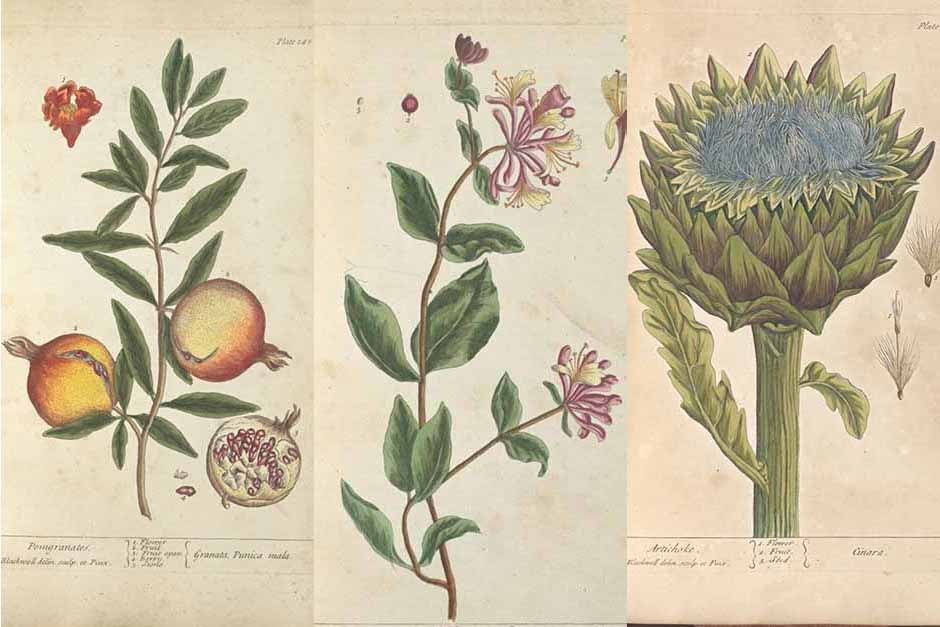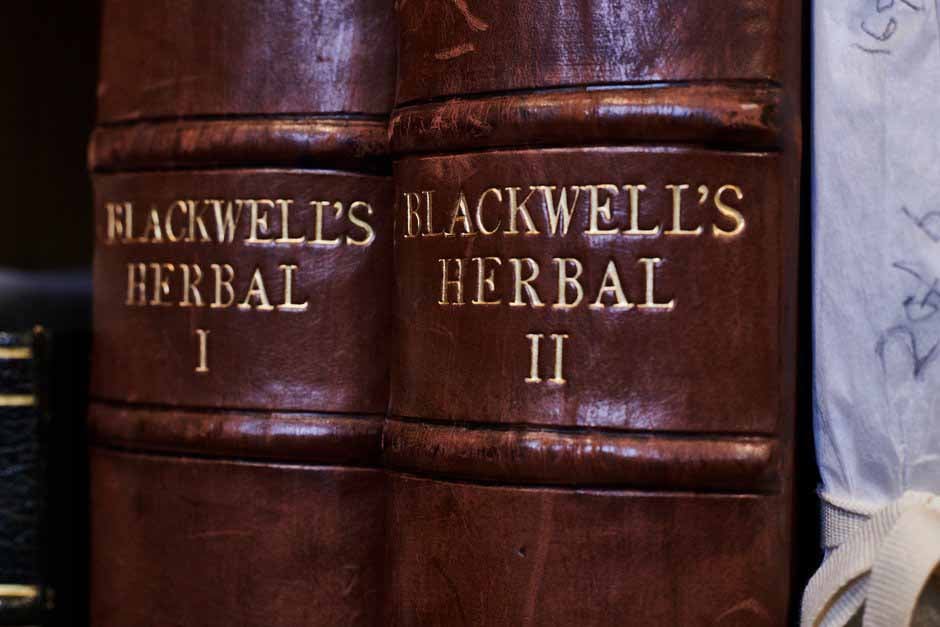
To mark her birthday, on April 23 1699, we explore the fascinating and complex history of Elizabeth Blackwell’s Curious Herbal, one of the treasures of the Lindey Library. Published in weekly instalments between 1737 and 1739, and including 500 illustrations, it was the first significant herbal to be produced by a British woman and a major achievement in the fields of medical botany and botanical illustration. But it was created by Elizabeth in desperate circumstances, in a bid to support her young family while her husband languished in debtor’s prison, and to secure his release.
A poor marriage
 Elizabeth Blackwell, née Simpson, was born in London on 23 April 1699. Her father, Leonard Simpson, was a painter, and from a young age she delighted in drawing and painting plants. In 1733 she married Alexander Blackwell, whose disreputable ways were linked to the production of the herbal. On paper, however, Alexander was an excellent catch. He came from a respectable family, was well-educated, and he had recently established his own printing business in London. Unhappily for Alexander, serving an apprenticeship to the trade was a prerequisite to practicing as a printer, a step he decided to skip. He was sued and, unable to pay, incarcerated as a bankrupt in debtor’s prison for two years. Faced with the threat of poverty, and forced to rely on her own resources, Elizabeth was urged by friends make use of her talent for drawing. It quickly became apparent that her pictures alone weren’t going to pay her husband’s debts. The idea for A Curious Herbal started to take root.
Elizabeth Blackwell, née Simpson, was born in London on 23 April 1699. Her father, Leonard Simpson, was a painter, and from a young age she delighted in drawing and painting plants. In 1733 she married Alexander Blackwell, whose disreputable ways were linked to the production of the herbal. On paper, however, Alexander was an excellent catch. He came from a respectable family, was well-educated, and he had recently established his own printing business in London. Unhappily for Alexander, serving an apprenticeship to the trade was a prerequisite to practicing as a printer, a step he decided to skip. He was sued and, unable to pay, incarcerated as a bankrupt in debtor’s prison for two years. Faced with the threat of poverty, and forced to rely on her own resources, Elizabeth was urged by friends make use of her talent for drawing. It quickly became apparent that her pictures alone weren’t going to pay her husband’s debts. The idea for A Curious Herbal started to take root.
Pioneering work
While women had a long history of gathering and preparing plants for medicinal use in domestic settings, there were few options for formal education or entrance to learned societies at the time. Elizabeth resolved to gain the patronage of the Royal College of Physicians and the Worshipful Society of Apothecaries, who were responsible for the operation of the Apothecaries’ Garden, which we now know as the Chelsea Physic Garden.
Elizabeth Blackwell, A Curious Herbal, Volume 1
Elizabeth was taken under the wing of Issac Rand, the Garden’s director, and she took rooms nearby the garden. She now had access to one of the most impressive collections of plants in the world. She was perfectly placed to document the garden’s many indigenous plants, as well as specimens arriving from across the British Empire.
Elizabeth decided to issue the book in weekly parts or ‘sets’ to buyers who subscribed in advance, which guaranteed her a regular stream of income throughout the project. Each set comprised four botanical illustrations plus a page of descriptive text, adapted from Joseph Miller’s 1722 herbal Botanicum officinale. She painstakingly drew each of the plants from live specimens in the Apothecaries’ Garden, readied the copperplates for engraving by a calligrapher and, for those subscribers willing to pay an extra shilling, hand-coloured the engraved plates. She kept up this rate of weekly production for a staggering 125 weeks.
An essential resource

In the early eighteenth century, plants were an essential resource for healthcare and Elizabeth designed the herbal to help her readers, including doctors and apothecaries, to develop an “exact knowledge” of their uses and effects in medicine. Choosing the right plant to treat an ailment was an increasingly precise science, and mistaking one plant for another could have severe consequences. A Curious Herbal provided up-to-the minute guidance on the physical characteristics of plants; where and when they could be found; their names in a variety of languages; and their curative properties. These descriptions were aided by Elizabeth’s highly detailed, analytical drawings, which depicted plants from different perspectives and in different stages of growth within the same picture.
Elizabeth Blackwell, A Curious Herbal, Volume 2
A tragic ending
Although only a modest success at the time of publication, the proceeds from A Curious Herbal helped Elizabeth to secure Alexander’s release from prison. He continued to accumulate debts, which Elizabeth eventually cleared in 1747 by selling the rights to the herbal to the bookseller John Nourse for a little over forty-seven shillings. By this time, her husband was in Sweden—having effectively abandoned the family in 1742—where he had found employment at Court. He was charged with treason after becoming embroiled in a dynastic power struggle and beheaded on 29 July 1747. Elizabeth did not remarry and died in London in 1758. Sadly, we know very little about her later life. A Curious Herbal is her only known published work, but it remains a landmark book in the fields of medical botany and botanical illustration and stands a testament to her remarkable strength of purpose, expertise, and creative powers.
About the author: Nicky Monroe is a librarian at the RHS Lindley Library at Vincent Square, London.
You might also be interested in...

